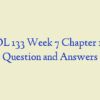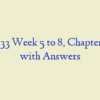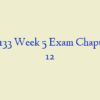Description
BIOL 133 Chapter 16 Week 12 Study Questions with Answers
Chapter 16 Week 12
10.0/ 10.0 Points
- A gene is made up of three exons (numbered consecutively) with two introns (intron 1 between exons 1 and 2 and intron 2 between exons 2 and 3). What would happen if there were a mutation at the 3’ splice site of intron 1?
- _________ is the first protein to bind to mRNA to being initiation of translation.
- In eukaryotes, where would a protective modification be found on mRNA?
- The portions of the mature mRNA where RNA-binding proteins can attach in order to change RNA stability are known as
- Overexpression of miRNAs can lead to a decrease of protein expression associated with some forms of cancer. What could a drug do to counter this effect?
- What would happen if there were a mutation in the operator of the trp operon?
- Epigenetics refers to a special kind of hereditary mechanism. Epigenetic changes do not change the DNA nucleotide sequence, yet their effect on gene expression can last for several generations. In one surprising study, it was found that the grandsons of men who suffered a famine were less likely to die of cardiovascular disease. The experience of famine made some cardio-protective change in the sperm of those grandfathers that was passed on. What type of change was likely responsible?
- Enhancers located hundreds of bases upstream of a gene can be brought to the promoter by _________.
- If every cell in the body gets the same DNA, how do the cells of an embryo make different structures and take on different roles? (Select all that apply.)
- What part of the ribosome is important in catalyzing peptide bonds?
Chapter 17 Week 13 Study Questions
10.0/ 10.0 Points
- An individual may have a mutation that causes them to break down a drug much more quickly than normal people. They were then provided with a higher dose, which was effective in treating the disease. This is an example of ________.
- Isolating all of the RNA out of an organism, subjecting it to reverse transcriptase, and then cloning all of the resulting DNA into plasmids is the process of creating
- A change in the level of an individual protein in a diseased cell is known as a
- In order to focus on only the expressed portions of DNA, what type of sequencing can be used?
- Three fish species are models for understanding different aspects of genes. Read the descriptions and decide what sort of genetics each is used for.
- Linkage analysis determines
- Before cellular DNA can be subjected to gel electrophoresis, what needs to happen?
- How can scientists tell how closely related two organisms are?
- ________ hotspots can decrease the accuracy of linkage maps.
- A species that is well studied so that we can learn more about the way we work is call a ________.
Chapter 18 Week 14 Study Questions
10.0/ 10.0 Points
- Reproductive barriers increasing over time would lead to ________.
- At a family get-together, your uncle says “I don’t believe in that evolution stuff. Scientists are always saying that something evolved because of ‘a gene for eyes’ or ‘a gene for wings’. Well, that’s crazy – how can one single gene build an eye or a wing?” How do you reply?
- In the process of adaptive radiation, there is usually one species from which others will quickly diverge. This original species is known as the
- Evolution is
- The first bird that evolved the ability to fly now had habitats never before available and soon branched out into many different species utilizing different resources, which is an example of ________.
- The difference between dispersal and vicariance when considering allopatric speciation is that dispersal has organisms leaving the homeland for a different one while vicariance
- A donkey and a horse can mate and produce a mule. Why are they not considered to be the same species?
- A superhighway is put down in a field separating a population of snails. Over time, they acquire mutations and become two different species. This is an example of ________ speciation.
- The place where Darwin noticed finch and tortoise differences that helped him develop his theory of evolution was ________?
- Two species of birds have different mating songs and so do not interbreed. This is an example of ________
Chapter 19 Week 15 Study Questions
10.0/ 10.0 Points
- What is the only way to introduce a new allele into a species?
- In South America, there is a specific type of frog where the male uses a loud call in order to attract females, even though this makes him more likely to be found by a predator. This is an example of
- The accumulation of mutations in a population over generations leads to
- If alleles that cause disease are constantly being selected against, why would there be any disease-causing alleles in a population over generations?
- The fact that being homozygous recessive for the CCR5 receptor protects people from being infected with HIV, thus causing an increase in the recessive CCR5 allele, is an example of
- Cheetahs, once hunted to near extinction, are now protected and recovering, although the number of different alleles at 5 different loci has dropped from 28 to 16. This is an example of ________.
- A group of birds migrate to a newly formed island and have a genetic makeup that is different from the original population. This is known as ________?
- Although Lamarck’s idea of inheritance of acquired characteristics was demonstrated to be false, there is a way in which exposure to some environmental factors can be passed on to offspring. This is known as
- Population bottlenecks and founder effects
- What does the term 2pq represent in the Hardy-Weinberg principle?
Chapter 20 Week 16 Study Questions
10.0/ 10.0 Points
- When a gene is passed to bacteria of a different species that brings with it an important feature, the resulting bacteria would provide complications in determining ________.
- The only taxonomic name not capitalized is the ________.
- Evidence has been gathered over the years that indicate mitochondria and chloroplasts were once bacteria. This idea is termed
- What is the proper way of writing the scientific name for humans?
- The idea of maximum parsimony derives from the assumption that traits are more likely to be passed down from an ancestor rather than ________.
- In homologous structures like the wings of a bat and the wings of a bird, it isn’t just the wings that make them homologous. It is due to the more complicated
- Humans belong in the phylum Chordata. The name Chordata is also known as the
- Since phylogenetic trees are essentially ________, they are subject to revision as new information is obtained
- What type of event is usually associated with each branch on a phylogenetic tree?
- Organisms in a specific clade would not only have structural features in common, but also share what other types of features?




